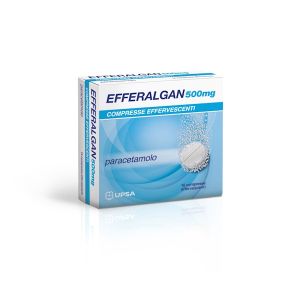Ship in Europe, Find out rates!

Efferalgan 500 Mg Paracetamolo 16 Compresse
BRISTOL-MYERS SQUIBB
Oral tablets containing paracetamol.
Therapeutic indications
Efferalgan 500 mg is used in the symptomatic treatment of mild to moderate pain and febrile conditions in adults and children. Symptomatic treatment of arthritic pain.
Dosage and posology
The tablets should be swallowed whole with a glass of water.
Efferalgan 500 mg tablets are reserved for adults and children weighing more than 26 kg (approximately 8 years or older). In children, the dosage regimens based on body weight must be respected and therefore the suitable formulation must be chosen. The correspondence between age and weight is only indicative.
- Children weighing between 26 kg and 40 kg (aged between 8 and 13 years approximately): the dosage is 1 tablet for each administration, to be repeated, if necessary, after an interval of at least 6 hours, without exceeding 4 tablets per day.
- Adolescents weighing between 41 kg and 50 kg (aged between 12 and 15 years approximately): the dosage is 1 tablet each administration, to be repeated, if necessary, after an interval of at least 4 hours without exceeding 6 tablets per day.
- Adults and adolescents weighing more than 50 kg (about 15 years or more): the usual unit dosage is one tablet for each administration, to be repeated, if necessary, after an interval of at least 4 hours without exceeding 6 tablets per day. Adults In case of more intense pain, two tablets can be taken at a time for a maximum of 3 times a day (3 g of paracetamol), always respecting an interval of at least 4 hours between doses.
Administer regularly: in children, the interval between administrations must be regular, both day and night, and should preferably be at least 6 hours, in adults and adolescents, an interval of at least 4 hours between administrations must always be respected. .
In case of severe renal insufficiency (creatinine clearance less than 10 ml / min), the interval between dosing should be at least 8 hours. Do not exceed 3 g of paracetamol per day, i.e. 6 tablets.
Maximum recommended dosage: In adults and adolescents weighing more than 40 kg, the total dosage of paracetamol should not exceed 3 g / day.
Overdose
There is a risk of intoxication, especially in patients with liver disease, in chronic alcoholism, in patients with chronic malnutrition, and in patients receiving enzyme inducers. In these cases, overdose can be fatal. Symptoms usually appear within the first 24 hours and include: nausea, vomiting, anorexia, paleness, malaise and diaphoresis. Overdose with acute ingestion of 7.5 g or more of paracetamol in adults and 140 mg / kg body weight in children causes hepatic cytolysis which can progress to complete and irreversible necrosis resulting in hepatocellular failure, metabolic acidosis and encephalopathy which can lead to coma and death. At the same time, increased levels of hepatic transaminases (AST, ALT), lactate dehydrogenase and bilirubin are observed, together with a decrease in the prothrombin value which may occur 12 to 48 hours after administration. Clinical symptoms of liver damage usually manifest themselves after one or two days, and reach their maximum after 3 - 4 days.
Contraindications
Hypersensitivity to paracetamol or propacetamol hydrochloride (precursor of paracetamol) or to any of the excipients.
Side effects
Skin reactions of various types and severities have been reported with the use of paracetamol including cases of erythema multiforme, Stevens-Johnson syndrome and epidermal necrolysis. Hypersensitivity reactions such as skin rash with erythema or urticaria, angioedema, larynx edema, anaphylactic shock have been reported. In addition, the following undesirable effects have been reported: thrombocytopenia, leukopenia, anemia, agranulocytosis, liver function abnormalities and hepatitis, kidney disorders (acute renal failure, interstitial nephritis, haematuria, anuria), gastrointestinal reactions and dizziness.
Pregnancy and breastfeeding
Clinical experience with the use of paracetamol during pregnancy and lactation is limited.
- Pregnancy
Epidemiological data on the use of therapeutic doses of oral paracetamol indicate that no undesirable effects occur in pregnant women or on the health of the fetus or neonates. Reproductive studies with paracetamol did not reveal any malformation or foetotoxic effects. However, paracetamol should only be used during pregnancy after a careful evaluation of the risk / benefit ratio.
- Feeding time
Paracetamol is excreted in small quantities in breast milk. Rash has been reported in breastfed infants. However, the administration of paracetamol is considered compatible with breastfeeding. However, caution should be used when administering paracetamol to breastfeeding women.
Special warnings
Paracetamol should be administered with caution to patients with mild to moderate hepatic insufficiency (including Gilbert's syndrome), severe hepatic insufficiency (ChildPugh> 9), acute hepatitis, concomitant treatment with drugs that impair liver function, glucose deficiency -6-phosphate dehydrogenase, haemolytic anemia.
Do not administer during chronic treatment with drugs that can determine the induction of hepatic monooxygenases or in case of exposure to substances that can have this effect. Paracetamol should be administered with caution in subjects with renal insufficiency (creatinine clearance ≤ 30 ml / min). Use with caution in case of chronic alcoholism, excessive alcohol intake (3 or more alcoholic drinks per day), anorexia, bulimia or cachexia, chronic malnutrition (low reserves of hepatic glutathione), dehydration, hypovolemia.
Expiration and retention
Check the expiration date indicated on the package. The expiry date indicated on the package refers to the product in intact packaging, correctly stored.
Warning : do not use the medicine after the expiry date indicated on the package.
Composition
One tablet of Efferalgan 500 mg contains:
Active principle
Paracetamol 500 mg.
Excipients
Hypromellose, povidone, croscarmellose sodium, glyceryl behenate, microcrystalline cellulose, magnesium stearate.
